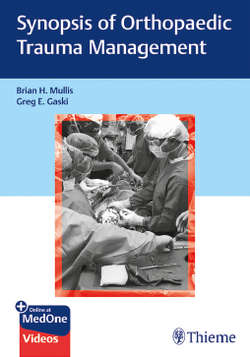Читать книгу Synopsis of Orthopaedic Trauma Management - Brian H. Mullis - Страница 23
На сайте Литреса книга снята с продажи.
III. Principles of Open Fracture Management in the Emergent Setting
ОглавлениеA. Clinical assessment and initial management
1. Neurovascular evaluation:
a. Vascular compromise is common.
b. Abnormal pulse exam following fracture reduction necessitates further evaluation with ankle brachial indices (ABI) and/or computed tomography angiogram to diagnose vascular injury.
c. Assess for neurologic deficit.
d. Limbs with open fractures can still develop compartment syndrome.
2. Soft tissue assessment:
a. Careful evaluation of all wounds and abrasions in fractured limbs is done for making the diagnosis of an open fracture. Be aware that the wound may be at some distance from the fracture location as the bone may have displaced during the injury.
b. Evaluate degree of contamination, wound size, and potential need for soft tissue reconstruction (rotational flap, free tissue transfer). High level of contamination may warrant more urgent operative debridement.
c. Entrapped tendons may prevent joint or fracture reduction.
d. Completely devitalized bone should be removed, unless it contains articular cartilage.
e. Sterile gauze should be applied to open wound either alone or with antiseptic solution. Consider packing wound with mild compression to control bleeding when clinically warranted.
B. Role of antibiotic treatment
1. There is level 1 evidence to support that antibiotic treatment prior to the operation has a protective effect against early infection compared to no antibiotics or placebo.
2. Antibiotics should be started as soon after injury as possible.
3. Weak evidence to support the best type of antibiotic to be administered, but consensus opinion is an intravenous administration of first-generation cephalosporin for all open fractures. Local differences or protocols may exist at trauma centers.
4. Gentamicin or equivalent is frequently supplemented for more contaminated injuries to give additional coverage against gram-negative bacteria.
a. Aminoglycosides carry an increased risk of nephrotoxicity in trauma patients.
5. Consider adding penicillin G or equivalent for gross contamination (fecal/soil/marine) for additional anaerobic bacterial coverage.
6. Clindamycin is an alternative to cephalosporin treatment in penicillin-allergic patients.
7. Piperacillin/tazobactam are acceptable alternative to cefazolin and gentamicin.
8. No consensus on length of antibiotic treatment warranted for therapeutic benefit. Many centers recommend 24 to 48 hours of treatment after each debridement until definitive soft-tissue closure or coverage.
C. Radiographic evaluation
1. X-rays should be performed primarily to assess the extent of osseous injury and guide the appropriate immobilization needed to stabilize the injury.
2. Consider CT imaging if further bone detail is warranted prior to surgical intervention.
